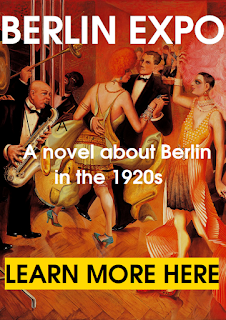 |
| Photo taken from Potsdamer Platz. Trams on their way to Leipzigerstrasse, passing between the two gate houses in greek style. |
What’s in a name ? The first part of the square's name is "Potsdamer" alright, but what does it mean? The answer is that the road to the town of Potsdam started there. But, you may wonder, why was Potsdam so important ?
You may have heard of Potsdam Conference in 1945, where the victor powers of WWII met. Then you're aware that for world leaders like Roosevelt, Churchill and Stalin, Potsdam was important enough. Of course, if they chose it as a meeting place was because Berlin was in ruins, but also because Potsdam had the appropriate facilities for such a summit meeting, namely Sans Souci, a rococo Palace built by Frederick the Great around 1750.
But Potsdam was a key place well ahead of that meeting, and the reason was that, even though the kings of Prussia had a palace in Berlin itself, they preferred Sans Souci with its beautiful and peaceful gardens, far from the nuisances of Berlin. The same reason why Louis XIV preferred Versailles to Paris. But the fact that the King had two residences, made it necessary to have good communications between them. Hence the importance of the Potsdam road, which became the first paved road in Prussia by 1790.
In those years, Berlin was encircled by an 8 km long palisade which had replaced the medieval ramparts. Its function was to prevent smuggling and to stop young men from escaping military service. In order to leave Berlin you had to get through that wall. Fourteen different gates were at your disposal, but if your goal was Potsdam, you would naturally choose the Potsdam gate (Potsdamer Tor). From there, four roads started, besides the one leading to Potsdam (but also to Leipzig, in Saxony).
 |
The sparsely populated space outside the gate wasn’t yet known as Potsdamer Platz. It was just "the area outside the Potsdam Gate". It wasn't before around 1830 that it got its name, Potsdamer Platz. The space inside the gate on the other hand had a well thought octogonal shape and from 1814 also a name : Leipziger Platz.
1838 happened something which changed this whole area dramatically : a train station was inaugurated, the first one in town. Its name was Potsdamer Bahnhof as it was the starting point for the new railway to Potsdam. Short after that, four new stations saw the light of day. From them, Berliners could board the train to Anhalt (a region west of Berlin), to Hamburg, to Stettin on the Baltic Sea or to Frankfurt an der Oder, to the south-east. Those stations were logically called Anhalter, Hamburger, Stettiner and Frankfurter (our days’ Ostbahnhof).
Those lines were run by different private operators. If you needed to transfer from one to the other, let’s say if you came from Potsdam but your final destination was Stettin, you were forced to traverse Berlin on foot or on a horse-drawn carriage. If you had baggage, that was not very convenient. The authorities realized that and in 1850 they built a Verbindungsbahn (Connection Railway), which didn’t run across town but rounded it, running alongside the city wall in a three quarters circle, connecting the five stations and making transfers much easier.
Tracks were laid at street level, though, meaning that the Connector Trains competed for space with pedestrians and horse traffic. That created trafic jams, not least in the point already known as Potsdamer Platz. Besides, it was a nuisance for the people living around, because of the smoke, the soot and the noise caused by the maneuvers necessary when the trains approached a station.
Above: a train passing alongside the city wall, today Ebertstrasse, thereby impeding the traffic through the gate houses, that is, through Potsdamer Tor and thereafter Leipziger Platz. Picture from around 1860.
The solution ? To build a new Connection Rail, a new circle, but a much larger one, which didn’t follow the old city wall but went a long way outside the city limits. This new circle was 11,2 km long, of which 8 were elevated, to prevent all conflicts with street traffic. This new layout, whose shape resembled a dog’s head, is the same as our days’ S-Bahn. It was opened in 1871, the same year when the German Empire was founded after Prussia’s victory agains France.
The old Connection Line doesn’t exist anymore. Furthermore, of the five train stations it served, only Potsdamer Bahnhof and Frankfurter Bahnhof (now Ostbahnhof) have still some long-distance activity. Stettiner Bahnhof (today Nordbahnhof) has only S-bahn trains, Hamburger Bahnhof has become art museum, and the once so prestigious Anhalter Bahnhof was destroyed during WWII.































